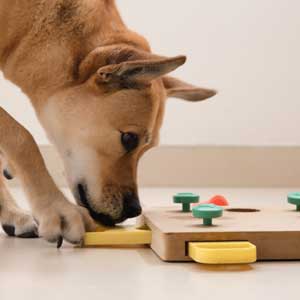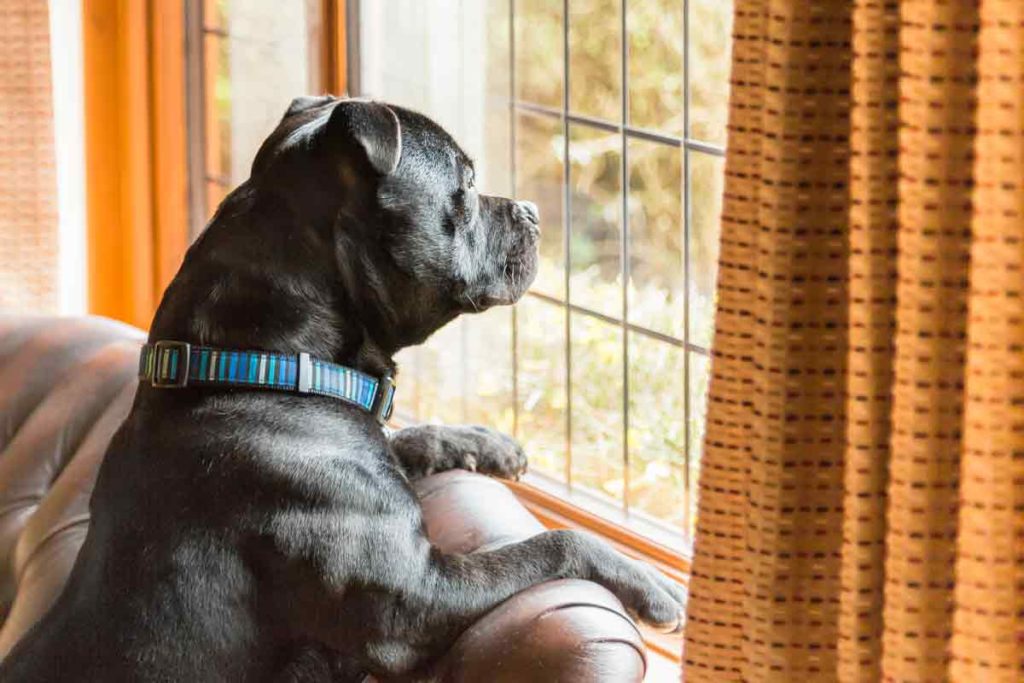Separation stress affects around 14 percent of dogs, according to the American Society for the Prevention of Cruelty to Animals (ASPCA). The percentage may be higher with the considerable number of dogs adopted during the pandemic. Whether your dog barks, chews, appears depressed or urinates, the extreme stress they experience from being apart from their people is both very real and exceedingly difficult for both of you. So, what are the causes of separation stress and how can you help your dog?
Table of contents
- Identifying separation stress
- What causes separation issues in dogs?
- How can you help stress related to separation?
- Management options
- What not to do
- Preventing separation-related stress
Identifying separation stress
Dogs with separation stress are overly attached or dependent on their family members. Fear Free Pets notes that these dogs cannot self-soothe or find comfort when they are left alone or separated from their family. If your dog has separation issues, you may notice that they exhibit extreme stress from the time you leave until you return. They also are likely to show signs of agitation while you are preparing to leave.
Does your dog try to remain close to you around the house, following you from room to room? Dogs can exhibit stress in many ways, so there is no one defining sign of separation-related stress. Identifying some of the symptoms of separation issues early can help pet parents address their pup’s stress and prevent issues from getting worse. Look out for:
- Restlessness
- Panting
- Hypersalivation and drooling
- Shaking/trembling
- Pacing
- Whining
- Excessive barking or howling
- Urinating or defecating in the house
- Destructive behaviors such as chewing and digging
- Attempting to escape
- Refusing to eat
Distress behaviors in cases of separation stress are persistent, starting immediately or within minutes of your departure. Your pup may act terrified to be alone and then be incredibly excited for you to return. Stressed fixation on destructive behaviors like chewing, digging, and trying to escape can be dangerous. Not only do you return to a wrecked house, but your dog can hurt herself in the process. Destruction can potentially cause broken teeth, injured paws, and other physical self-harm.
What causes separation issues in dogs?
There are a number of different things that can potentially cause a dog to develop separation problems. However, each dog is unique and may react differently to various situations and events. According to research by Rebecca Sargisson, dogs are more likely to have separation-related behavior problems if they are male, rescued, and separated from their littermates before they are 60 days old.
ASPCA also emphasizes the significance of rescue and shelter backgrounds in predicting whether a dog is prone to separation issues. They note that shelter dogs being particularly susceptible to separation stress suggests that loss of an important person or group of people in a dog’s life can lead to separation issues. According to Fear Free Pets, other potential causes of separation stress include:
- Change of guardian or family – Being abandoned, surrendered, or given to another family can be a triggering event for dogs. Shelter dogs who have experienced a traumatic separation from their previous owners often exhibit symptoms of separation stress.
Separation-related stress can also be associated with changes in the composition of a dog’s household. When family members suddenly become absent, whether due to divorce, death, or departing for college, dogs notice and can develop stress.
- Change in residence – Dogs do not necessarily understand what is happening when their family moves homes. A new living space can throw your dog off and cause separation issues to develop. This can be true even if they were perfectly fine at the last house.
- Change in routine – Our dogs thrive with regular schedules. An abrupt change in schedule can trigger the development of separation stress. For example, if an owner works from home and spends all day with their dog but then gets a new job that requires them to be out of the house for long, the dog may have difficulty adjusting.
- Limited or no experience being left alone – Being comfortable at home alone can take practice. If your pup is not used to you leaving, a long and or traumatic period alone can trigger separation stress.
Personality can also play a role in the development of separation stress. Some dogs are simply more independent or clingier than others. Unfortunately, even a single traumatic event that your dog experiences while you are gone can suddenly lead to separation issues. So, what do you do when your pup cannot be away from you?
How can you help stress related to separation?
Intense distress in your dog every time you leave the house can be difficult to watch. Research shows that behavior modification focused on systematic desensitization and counterconditioning is the most effective strategy for addressing separation stress in dogs. This process involves gradually building your dog up to longer periods of time alone without stress. Counterconditioning aims to help your dog develop an association between being alone and good things, like treats and toys.
Fear Free Pets recommends pet parents use these methods to change their dog’s fearful, nervous, or aggressive reaction to a pleasant, relaxed one instead. The dog will eventually learn that whatever they feared actually predicts good things, like yummy food. In the case of separation-related stress, dogs will figure out that separation has its rewards. Here is a step-by-step guide to working through separation stress with your dog:

Before you leave
- Immediately before you leave, give your dog food or a special toy. This can create an association between you leaving and a positive experience. Offer your dog a puzzle toy like a Kong stuffed with food. Some high-value treats can include cream cheese, spray cheese, peanut butter, a frozen banana and cottage cheese, or canned dog food and kibble.
- Note that highly stressed dogs usually may not eat when their people are not home. This can make rewarding them with treats and successfully counterconditioning challenging.
- You can make your departures less distressing by desensitizing your dog to the signs that you are about to leave. Try picking up your keys or putting on your coat, then go make dinner or watch TV on the couch instead of leaving.
- Work with your pup to establish a cue word or action every time you leave to signal that you will be back. Say “I’ll be back” (or any phrase that feels natural) as you reach for the door, and quickly return each time. This builds up an association between your cue and a stress-free period of alone time for your dog.
- Do not make departures and arrivals a big deal. Talk to your dog in a calm voice, move around at a normal pace, and resist the urge to give your dog too much attention.
When you go
- Start by leaving your dog home alone for very short periods of time. For dogs with extreme separation issues, owners may have to start with simply reaching for or turning the doorknob.
- Repetition is key to successful desensitization. Practice repeatedly with very short trips away before gradually moving to longer amounts of time apart.
- Gradually increase the duration of your separations over many weeks of daily sessions.
- Avoid fear in order to effectively address separation-related stress. If your dog starts to appear distressed at any point, reduce the length of their absences again until your dog’s behavior improves. You can then resume the gradual increase in the length of your absences.
When you come home
- Calmly enter your house, take off your coat, and go about your activities until your dog settles down.
- Resist the temptation to give your dog vigorous pets and praise until they settle down. Some pet parents even refuse to make eye contact or otherwise acknowledge their dog at first. When you do greet them, do not be overly enthusiastic. This can encourage their frenzied behavior.
- Remove special toys and treats as soon as you get home. Your dog should only have access to these when they are by themselves to maintain the positive association.
Management options
As previously mentioned, fear should be avoided as much as possible when working to address your dog’s separation stress. If your pup gets distressed at any point, this lapse in progress can be severely detrimental to their progress. And desensitization and counterconditioning are not designed to work overnight, so pet parents will need to temporarily manage their dog’s separation issues in the meantime.
It can take time for your dog to unlearn their panic response to your departures. To help you and your dog cope in the short term, consider the following interim solutions:
- Doggy daycare – If your dog enjoys the company of other pups, you may want to consider dropping them at doggy daycare while you must be away from them. Note that this option can be expensive. It is also not a great fit for every dog, so consider your dog’s personality and temperament before leaving them at a kennel facility.
- Enlist the help of family or friends – Your pup is likely to be comfortable with and love your close family and friends. If they are available to look after your pup, it can be cheap and convenient for you while also fun for your dog.
- Hire help – If loved ones are not available or your dog does not like socializing much, hiring a dog sitter might be a good option. Pet owners can get help either in their own home or a sitter’s home from popular platforms like Care.com, Rover, and Wag.
- Take your dog to work – This certainly is not always an available option but can be a great solution to managing separation stress. If you have a pet-friendly workspace, your dog never has to leave your side.
What not to do
While there are ways to help your dog with separation-related stress, the Humane Society of the United States warns that there are also things that will not help:
- Punishment – Reprimanding your dog for having separation issues is not effective for addressing their stress and can make the situation worse.
- Another dog – Getting your dog a companion usually does not help a stressed dog. Their stress is the result of their separation from you, not just the result of being alone.
- Crating – If crated, your dog will still engage in stress responses. They may urinate, defecate, howl, or even injure themself attempting to escape. This can be dangerous and counterproductive in addressing separation issues, but sometimes is the only resort when destructive behaviors are towards your personal belongings. Making sure to use an “airline” kennel, which is entirely enclosed with no wiring to get paws caught, is likely the best solution if necessary.
- Obedience training – While formal training is always advisable, the Humane Society emphasizes that separation stress is not the result of disobedience or lack of training. However, formal training can be a tool to tire out your pup before you leave.
Preventing separation-related stress
Before your canine companion shows any signs of separation issues, teach them to like, or at least tolerate, being alone.
- Exercise – Make sure your dog gets plenty of physical exercise and mental stimulation. A tired, contented dog is more likely to settle down whenever you leave. Great options range from long walks and fetch to trick training and puzzle toys.
- Early exposure and experiences – Ensure your dog gets a wide range of experiences outside your home and with other people while they are a puppy. Getting exposed to new things during key development stages (between five and 10 months of age) will help your dog gain confidence and be comfortable in any situation, including being home alone.
- Predictable schedules – Stable household routines and periods away from your dog can help make your absences no big deal. As previously mentioned, dogs thrive with a schedule.
- Encourage independence – Dog owners should discourage excessive attachment. Encourage your dog to “stay” while you leave the room or reward and praise them for venturing through the house without you. Hide treats or special toys stuffed with food in separate rooms. You should also minimize excitement when you leave and return—again, no big deal.
Preventing your pup from developing separation stress and learning how to address situational stress can save you and your dog a lot of stress and heartache down the road.
How can ElleVet CBD + CBDA help your dog’s separation-related stress?
ElleVet’s Calm & Comfort situational use chews provide maximum support for dogs in stressful situations like being home alone, allowing them to remain calm while they are away from you without setting off stress-related responses. These chews, when given between 1-1.5 hours ahead of your departure, are extremely effective in addressing your dog’s acute level of stress, by truly calming without sedating, ElleVet’s CBD + CBDA oils, chews, and soft gels can lead to a reduction of their fear response to separation over time. They may never enjoy being away from you. But if they can manage their stress and respond calmly, then you both will be much happier. And we all want a happy and relaxed pup!
Any health or medical information in ElleVet blogs is from a variety of public and reputable sources. This information is intended as an education resource only and is not a substitute for expert professional care.








